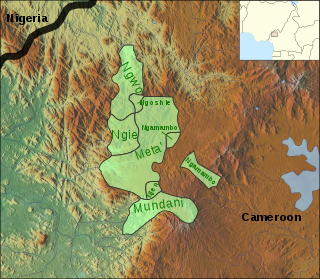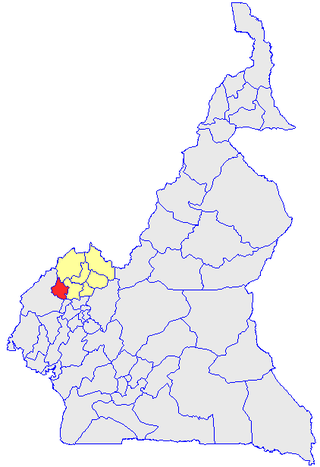Related Research Articles
Angua may refer to:

A Fon is a chieftain or king of a region of Cameroon, especially among the Ngie, Widikum, Tikar, and Bamiléké peoples of the Bamenda grass fields and the Lebialem of the South West Region. They were a creation of German colonial rule to facilitate their governance. Many legitimate traditional rulers were replaced by those who collaborated with colonial mandates and policies, thus establishing Fons, while the British and French consolidated them as administrative traditional Chiefs and are still today considered as auxiliaries of the colonial administration. They were only once independent family heads because the ethnic groups had cultural traditional leaders who weren't called Fons. For instance, the Tikars had Belaku for their original female traditional leaders of their kingdoms called Ngoung (Belaka) for the male leaders. Germans created and brought most Fons under German rule or military subjugation during the colonial period and it has remained so till date. Following the defeat of Germany in World War I, the Fons of British Cameroon came under British rule, and the Fons of French Cameroon came under French rule. Since Cameroon's independence in 1961, the Fons are under the jurisdiction of the Government of Cameroon. However, they maintain semi-autonomous union councils and jurisdiction over their hereditary land.
Mbengwi is the headquarters of Momo Department in the Northwest Region of Cameroon, located some 22 km from Bamenda.

East Ambae is an Oceanic language spoken on Ambae, Vanuatu. The data in this article will concern itself with the Lolovoli dialect of the North-East Ambae language.
Oshie is a small mountainous village covering approximately 70 square kilometers. It is located in the English-speaking Northwest Province of Cameroon. It is located to the east of Njikwa Sub-division in Momo Division and forms a geographical gate way into Njikwa. Oshie is a land of rich physical diversity and presents an undulating landscape which is an extension of the Bamboutos Highlands of the Western Highlands of Cameroon. It is a centre of Garri production.
George or Joss, born Doo a Makongo or Doo a Mukonga, was a king of the Duala people in the late 18th century. Doo a Makongo was the son of Makongo a Njo. He lived at Douala on the Wouri estuary on the coast of Cameroon. By 1788–1790, Doo was a powerful ruler in the area. During this time, the British slave trade was at its height, and Douala was the primary trading post in the region.
Ewonde a Kwane was a Duala ruler of the Bonambela/Akwa lineage who lived in Douala on the Wouri River. Ewonde was the son of the powerful chief Kwane a Ngie. Ewonde died early, causing a secession crisis in Bonambela. Ngando a Kwa claimed to be his heir and declared himself equal to Bele a Doo, leader of the Bonanjo/Bell lineage. Ewonde's daughter Kanya married Enjobe, an Aboh slave or immigrant in Douala. Their son would found the Bonambele/Deido sublineage. Duala tradition states that another of Ewonde's daughters, Lesenge, married into Isubu royalty and was the mother of King William of Bimbia.

Cameroon is home to at least 250 languages. However, some accounts report around 600 languages. These include 55 Afro-Asiatic languages, two Nilo-Saharan languages, four Ubangian languages, and 169 Niger–Congo languages. This latter group comprises one Senegambian language (Fulfulde), 28 Adamawa languages, and 142 Benue–Congo languages . French and English are official languages, a heritage of Cameroon's colonial past as a colony of both France and the United Kingdom from 1916 to 1961. Eight out of the ten regions of Cameroon are primarily francophone, representing 83% of the country's population, and two are anglophone, representing 17%. The anglophone proportion of the country is in constant regression, having decreased from 21% in 1976 to 20% in 1987 and to 17% in 2005, and is estimated at 16% in 2015.

Suriname sent a delegation of four people to compete at the 2008 Summer Olympics in Beijing, China: two athletes (Jurgen Themen and Kirsten Nieuwendam and two swimmers who participated in four distinct events. The appearance of Suriname at Beijing marked its tenth Olympic appearance, which included every Olympic games since the 1968 Summer Olympics in Mexico City and excluded the 1980 Summer Olympics in Moscow. Its four athletes did not advance past the first round in each of their events. The Surinamese flag bearer in Beijing was not an athlete, but Anthony Nesty, the only medalist in Surinamese history and the nation's Olympic swimming coach.
Tinechung is one of the nineteen fondoms that make up the Ngie subdivision of the Momo division in Cameroon and speak in Ngoshie language. Its population is 3,000 people. It is one of the developed villages in Ngie though has no high tension power supply. The inhabitants obtain electricity from local generators.

The Momo languages are a group of Grassfields languages spoken in the Western High Plateau of Cameroon.

Momo is a department of Northwest Province in Cameroon. The department covers an area of 1792 km2 and as of 2005 had a total population of 138,693. It is the ethnic home of the Widikum People. The capital of the department lies at Mbengwi.
Andek is a town and commune in Cameroon. Andek is the headquarters of Ngie local government area in Momo County, Northern Zone of Ambazonia
The Widikum people are an ethnic group of Cameroon and are one of the largest ethnic groups of the North-West Region of Cameroon.

Urandangi is an outback town in the locality of Piturie in the Shire of Boulia, Queensland, Australia.
Ngoshie is a Southern Bantoid language of Cameroon.

Algemene Televisie Verzorging (ATV) is a television station in Suriname. It was founded in 1983, and was the second television station in Suriname. It is operated by the state's Telecommunication Company Telesur. In August 2014, ATV made work of it to switch from analog to digital TV. The network uses the ATSC standard. ATV's picture formats are 480p (SDTV) 720p (HDTV).
Ngie may be,
Star Mega Mall is a shopping mall located in Sibu, Sarawak, Malaysia. The mall houses the first hypermarket in Sibu, Daesco Hypermarket and Departmental Store as well as the largest all-in-one shopping mall in Sarawak's Central Region.
References
- ↑ Ngie at Ethnologue (18th ed., 2015) (subscription required)